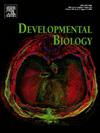Development of the zebrafish anterior lateral line system is influenced by underlying cranial neural crest
IF 2.5
3区 生物学
Q2 DEVELOPMENTAL BIOLOGY
引用次数: 0
Abstract
The mechanosensory lateral line system of aquatic vertebrates comprises a superficial network of distributed sensory organs, the neuromasts, which are arranged over the head and trunk and innervated by lateral line nerves to allow detection of changes in water flow and pressure. While the well-studied zebrafish posterior lateral line has emerged as a powerful model to study collective cell migration, far less is known about development of the anterior lateral line, which produces the supraorbital and infraorbital lines around the eye, as well as mandibular and opercular lines over the jaw and cheek. Here we show that normal development of the zebrafish anterior lateral line system from cranial placodes is dependent on another vertebrate-specific cell type, the cranial neural crest. We find that cranial neural crest and anterior lateral lines develop in close proximity, with absence of neural crest cells leading to major disruptions in the overlying anterior lateral line system. Specifically, in the absence of neural crest neither supraorbital nor infraorbital lateral lines fully extend, such that the most anterior cranial regions remain devoid of neuromasts, while supernumerary ectopic neuromasts form in the posterior supraorbital region. Both neural crest and cranial placodes contribute neurons to the lateral line ganglia that innervate the neuromasts and in the absence of neural crest these ganglia, as well as the lateral line afferent nerves, are disrupted. Finally, we establish that as ontogeny proceeds, the most anterior supraorbital neuromasts come to lie within neural crest-derived frontal and nasal bones in the developing cranium. These are the same anterior supraorbital neuromasts that are absent or mislocated in specimens lacking neural crest cells. Together, our results establish that cranial neural crest and cranial placode derivatives function in concert over the course of ontogeny to build the complex cranial lateral line system.

斑马鱼前侧线系统的发育受到潜在颅神经嵴的影响。
水生脊椎动物的机械感觉侧线系统包括一个分布在头部和躯干上的感觉器官表层网络,即神经突,由侧线神经支配,可以检测水流和压力的变化。虽然对斑马鱼后侧线的充分研究已经成为研究集体细胞迁移的一个强有力的模型,但对前侧线的发育知之甚少,它产生眼睛周围的眶上线和眶下线,以及下颌和脸颊上的下颌和眼窝线。我们发现斑马鱼前侧线系统的正常发育依赖于另一种脊椎动物特有的细胞类型——颅神经嵴。我们发现颅神经嵴和前侧线发育密切,缺乏神经嵴细胞导致上覆前侧线系统的主要破坏。具体来说,在没有神经嵴的情况下,眶上和眶下的侧线都不能完全延伸,因此大多数前颅区仍然没有神经突,而在眶上后方区域形成多余的异位神经突。神经嵴和颅基都向支配神经突的侧线神经节提供神经元,在神经嵴缺失的情况下,这些神经节以及侧线传入神经都被破坏。最后,我们确定,随着个体发育的进行,大多数前眶上神经乳房位于发育中的头盖骨的神经嵴衍生的额骨和鼻骨内。在缺乏神经嵴细胞的标本中,这些是相同的眶前上神经突缺失或错位。总之,我们的研究结果表明,颅神经嵴和颅基质衍生物在个体发育过程中协同作用,建立了复杂的颅侧线系统。
本文章由计算机程序翻译,如有差异,请以英文原文为准。
求助全文
约1分钟内获得全文
求助全文
来源期刊

Developmental biology
生物-发育生物学
CiteScore
5.30
自引率
3.70%
发文量
182
审稿时长
1.5 months
期刊介绍:
Developmental Biology (DB) publishes original research on mechanisms of development, differentiation, and growth in animals and plants at the molecular, cellular, genetic and evolutionary levels. Areas of particular emphasis include transcriptional control mechanisms, embryonic patterning, cell-cell interactions, growth factors and signal transduction, and regulatory hierarchies in developing plants and animals.
 求助内容:
求助内容: 应助结果提醒方式:
应助结果提醒方式:


